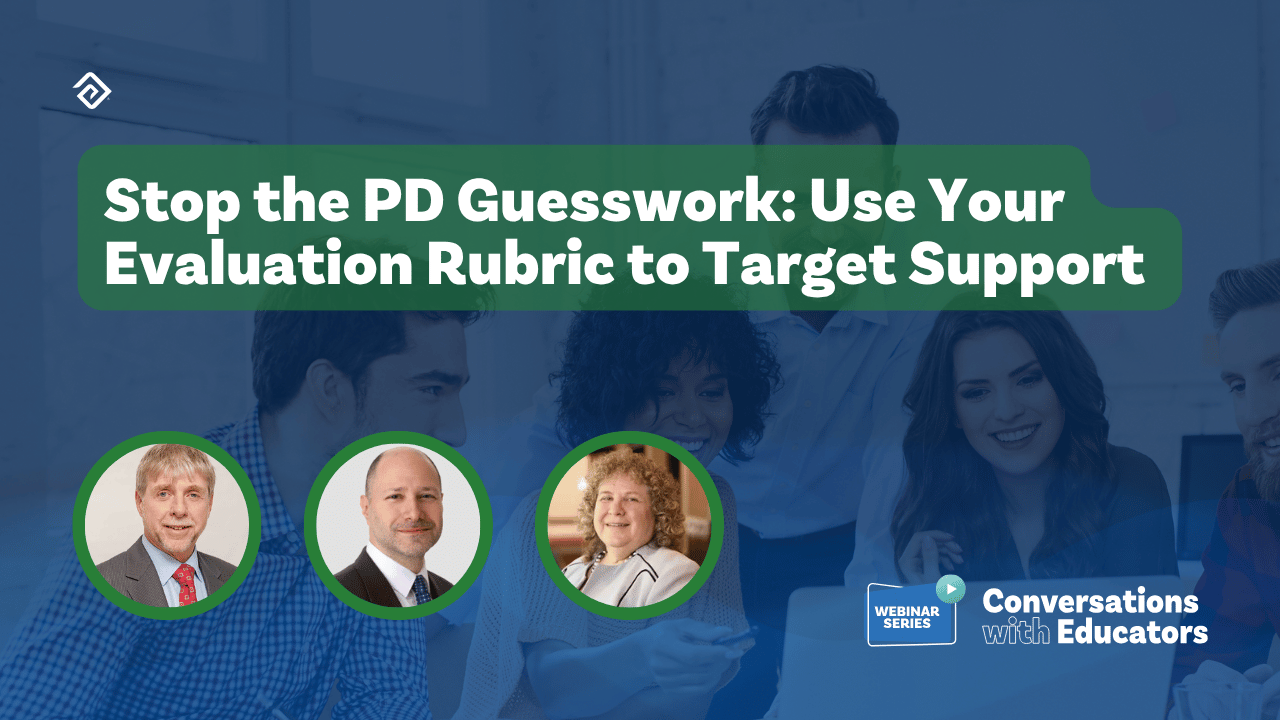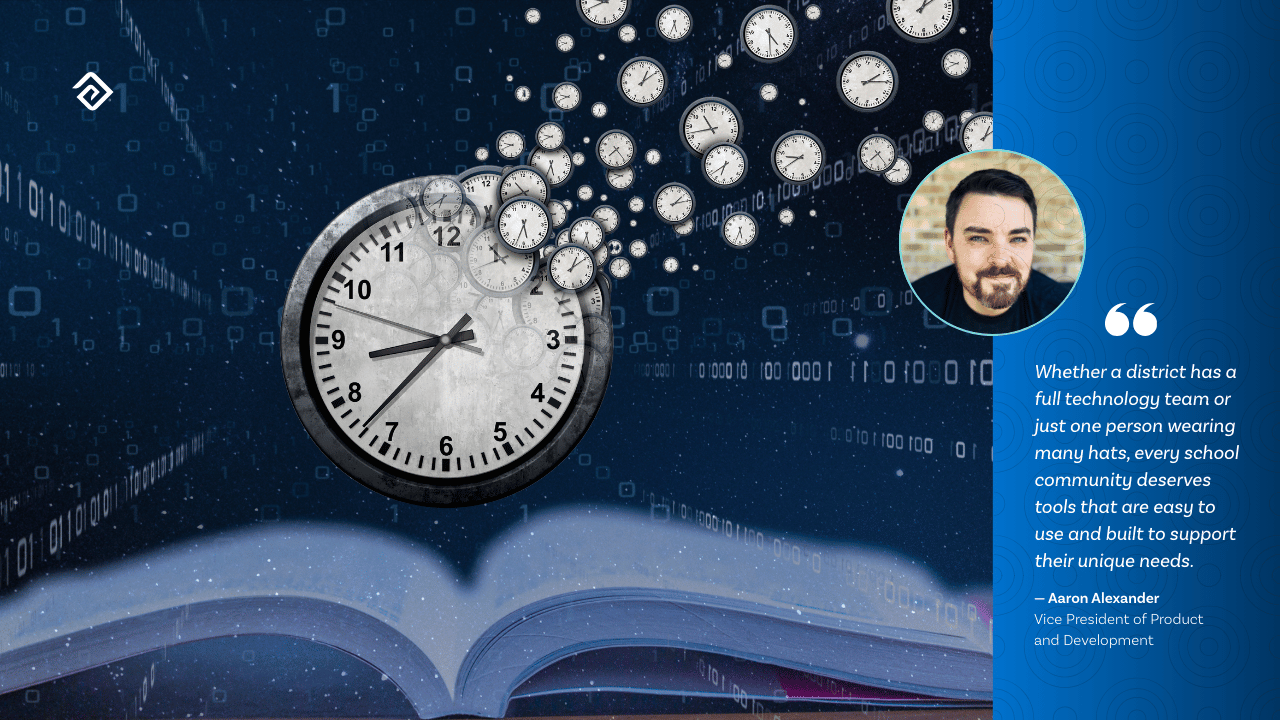Stop the PD Guesswork: Use Your Evaluation Rubric to Target Support
Every school leader wants professional development (PD) that leads to real growth, but guessing what teachers need rarely produces lasting results.
In our recent webinar, Stop the PD Guesswork: Use Your Evaluation Rubric to Target Support, Education Advanced’s Dr. Kim Tunnell sat down with Matt Perini, Senior Director of Content Development at Silver Strong & Associates, and Rick Fisher, Thoughtful Classroom Instruction & Leadership Coach, to discuss how administrators can use their evaluation rubrics to deliver targeted, effective support.

How Can Observation Data Guide Professional Development?
Fisher: Thinking back to my experiences as a principal and district leader, I always focused on the relentless pursuit of improvement. In other words - are we getting better at teaching, learning, and leading every year? We must prioritize improvement around Tier 1 instruction because we know it gives us the biggest return for our time and resources. The question is how?
There are three shifts that help connect teacher observation and professional development.
- Shift Professional Learning Communities (PLCs) from problem sessions to opportunities for professional learning.
- Shift teacher observations from evaluations of instruction to vehicles that improve instruction.
- Shift the teacher evaluation framework from a checklist of vague behaviors to a concrete guide for growth.
Breaking down what accomplished and exemplary teaching really looks like helps teachers identify what to work toward. When they can see the difference and have tools to apply it, growth feels achievable instead of intimidating.
Perini: One thing that can get in the way is what we call rubricitis. There’s a lot of language and a lot of indicators that make the process dense. What Rick and his schools have done so well is find the golden thread through it all, focusing on what matters most for great teaching.
Effective schools build the conditions that let observation data truly drive professional development, and at the heart of that is clear, actionable feedback.

How Can Leaders Deliver Feedback That Drives Action?
Perini: We talk about the Four P’s of effective feedback—Provide evidence, Praise, Pose, and Propose.
- Provide evidence by describing what you saw objectively.
- Praise with purpose by identifying what the teacher did and the impact it had.
- Pose one reflective question that makes the teacher think intentionally about their choices.
- Propose a concrete tool or strategy they can actually use.
Remember, you don’t have to write a novel! Less is more!
Tunnell: This really gives teachers autonomy and creates true collaboration instead of one-way communication.
When feedback is specific, actionable, and centered on growth, it becomes something that helps teachers, instead of being something they fear. That’s what makes observation data valuable and turns evaluation into real professional learning.
What Are Practical Ways to Support Just-in-Time PD?
Fisher: Just-in-time PD means giving teachers something they can use immediately. This morning, teachers told me they were struggling to get students to provide evidence. I shared Forced Choice, which uses controversy to drive discussion. They could go back that same afternoon and use it right away.
Perini: The real challenge is moving from observation data to practices that make a difference. At Thoughtful Classroom, we’ve spent decades refining research-based tools that are simple and practical.
For example, when a teacher asks mostly factual questions, you can recommend Questioning in Style, a tool that helps diversify recall, reasoning, creative, and real-world questions. When students seem disengaged in note-taking, use Window Notes to divide a page into four panes for facts, questions, connections, and feelings. It changes how students engage with learning.
We’re excited to launch The 21 with Education Advanced, twenty-one classroom-ready strategies that connect directly to observation rubrics inside of the Evaluation tool. This makes it easy for observers to suggest specific tools tied to what they see in classrooms, creating a common language for growth.

How Can District Leaders Use Observations to Plan Professional Development?
Fisher: At both the school and district level, we can start by asking four questions:
- What do we know about good instruction?
- What is so in our classrooms (current state of instruction)?
- How can we improve it?
- And what do we see now after we act?
Two structures help guide that process.
The first is the Learning Walk. Teachers and administrators visit classrooms together, focusing on one element—like questioning—and then reflect as a group. It’s not about clipboards or checklists; it’s about understanding what’s really happening and improving together. That builds collective efficacy and a sense of “we.”
The second is the Learning Club, a cycle within PLCs where teachers learn a new tool, try it out, and come back to share results. The process empowers teachers to solve problems of practice and builds capacity across the district.
Tunnell: This creates a culture of learning. Everyone rows in the same direction, and the process feels formative, collaborative, and not punitive.
How Can Data Support Strategic Planning?
Perini: Tools like Evaluation’s heat map report make it easy to see strengths and needs across campuses and district in real time. All that observation data is synthesized in one place so leaders can target their professional learning where it’s needed most.
Tunnell: That’s why we continually develop tools that help educators connect data to instructional improvement, because when we use data well, we improve both teaching and student outcomes.
Final Thoughts
Perini: The 21 has been years in the making, and it’s designed to make teacher growth simpler, faster, and more effective. Educators can search for PD in Evaluation by rubric term, by instructional area, or by specific challenge and find twelve-minute tutorials that make immediate impact.
Tunnell: When administrators have tools that connect data, feedback, and strategies, growth stops being guesswork and becomes part of the culture. That’s how we move from compliance to confidence and help teachers reach their full potential.
When professional learning, data, and tools align, districts create a culture where growth is intentional, not incidental. Every observation becomes an opportunity, every conversation builds confidence, and every teacher has the support to elevate instruction. When systems work, professional development stops being a task, and becomes a shared journey toward excellence.
If you missed the live session, you can watch the full webinar here to hear the complete conversation and access strategies for connecting evaluations to meaningful professional growth.
If your school is interested in new ways to improve the learning experience for children, you may also be interested in automating tasks and streamlining processes so that your teachers have more time to teach. Education Advanced offers a large suite of tools that may be able to help:
- Evaluation: A staff evaluation solution for documenting every step of the staff evaluation process, including walk-throughs, self-evaluations, supporting evidence, reporting, and performance analytics.
- Pathways: A graduation tracking tool that enables administrators and counselors to create, track, and analyze graduation pathways, ensuring secondary students stay on track to graduate.
- TestHound: Our test accommodation software helps schools coordinate thousands of students across all state and local K-12 assessments while considering various accommodations, such as for reading disabilities, physical disabilities, and translations.
More Great Content
We know you'll love





